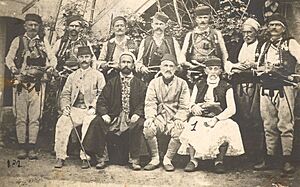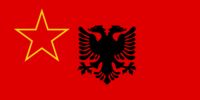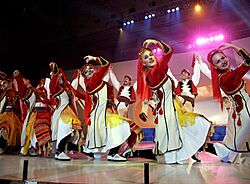Kosovo Albanians facts for kids

Albanians in Kosovo (2011 census)
|
|||||||||||||||||
| Regions with significant populations | |||||||||||||||||
|---|---|---|---|---|---|---|---|---|---|---|---|---|---|---|---|---|---|
| Other regions | |||||||||||||||||
|
|||||||||||||||||
|
|||||||||||||||||
| Languages | |||||||||||||||||
| Albanian (Gheg Albanian) |
|||||||||||||||||
| Religion | |||||||||||||||||
| Predominantly Sunni Islam Christian minority (Catholic · Protestant) |
|||||||||||||||||
| Related ethnic groups | |||||||||||||||||
| Albanians | |||||||||||||||||
The Albanians of Kosovo (Albanian: Shqiptarët e Kosovës), also known as Kosovo Albanians or Kosovars, are the largest group of people living in Kosovo.
Kosovo Albanians are part of a bigger group called Ghegs. Ghegs live in northern Albania, northern parts of North Macedonia, and southern Serbia. They speak a type of Albanian called Gheg Albanian.
In 1991, about 1.6 million Albanians lived in Kosovo. This was about 81.6% of all people there. By 2011, their population grew to about 92.93% of Kosovo's total population.
Contents
A Look at Kosovo Albanian History
Early Times and the Middle Ages
Old place names show that Albanian was spoken in Kosovo even before the 7th century. During the Middle Ages, between 1246 and 1255, a Serbian ruler named Stefan Uroš I mentioned Albanian place names in the Drenica valley.
Later, in the 1300s, Serbian royal decrees also talked about Albanian villages near Prizren and in the Plains of Dukagjin. Some villages like Ujmir and Gjonaj were mentioned. Gjonaj might even have one of the oldest Catholic churches in Kosovo.
Ottoman records from the 1400s and 1500s show that many areas in Kosovo, like the Has region, had a large Albanian population. These records also show that new people arrived, but the area was not emptied or fully settled by new groups.
Kosovo was part of the Ottoman Empire from 1455 to 1912. During this long time, many people in Kosovo became Muslim. Today, most Kosovo Albanians follow Sunni Islam. The Ottomans even called parts of Kosovo and southern Serbia "Arnavudluk," which means Albania.
The 1800s: Changes and New Ideas
In the late 1870s, many Albanians had to leave their homes in southern Serbia during a war. They moved to Kosovo and are known as muhaxhir, meaning "exiles."
Back then, people in Kosovo didn't think of themselves as one big Albanian nation in the same way we do today. Their identities were more about their job, their region, or their religion. Sometimes, Muslim and Christian Albanians had disagreements.
In 1878, the League of Prizren was formed in Prizren. This happened because European powers had given some Albanian areas to Serbia and Montenegro. Albanian leaders, mostly from Kosovo, met to protest this. They wanted to unite all Albanian-speaking areas within the Ottoman Empire into one large Albanian region. However, after three years of fighting, the Albanians were defeated. Many leaders were arrested or executed.
The 1900s: Wars and New Borders
In 1912, during the Balkan Wars, Serbia and Montenegro took control of most of Kosovo. Many Serb families moved into Kosovo, and the number of Albanians decreased.
Between 1918 and 1929, under the Kingdom of Yugoslavia, Albanians in Kosovo faced difficulties. Kosovo was divided into different regions.
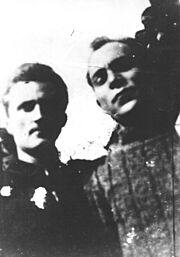
During World War II, parts of Kosovo became part of Italian-controlled Albania. After Italy surrendered in 1943, German forces took over. After the war, Kosovo became a province within Serbia, which was part of Democratic Federal Yugoslavia.
In 1974, Kosovo gained more self-rule. It became an "Autonomous Province" within Serbia. This meant it had its own government leaders and a seat in the federal government. Both Serbian and Albanian languages became official in Kosovo.
In the 1970s, some Albanians wanted Kosovo to become a full republic within Yugoslavia, or even fully independent. The government tried to control these movements.
In 1981, Albanian students in Kosovo protested, asking for Kosovo to become a republic. These protests were stopped by the government. Later, in 1990, Kosovo's self-rule was taken away.
On July 2, 1990, an Albanian parliament in Kosovo declared Kosovo an independent country. A year later, they held a vote where 99.88% of people voted for independence. However, this was only recognized by Albania.
In the early 1990s, the Kosovo Liberation Army (KLA) was formed by some Albanians. They started attacking Serbian police. After a civil unrest in Albania in 1997, the KLA got many weapons. They also received money from Albanians living in other countries.
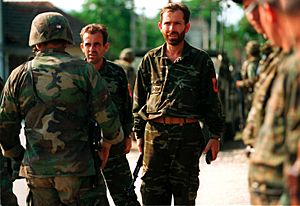
In 1999, after a tragic event called the Račak massacre, international talks were held in France. The Albanians accepted a peace plan, but the Yugoslav government did not. This led to NATO air strikes against Yugoslavia. The bombing lasted from March to June 1999, when a peace agreement was signed.
The 2000s: Independence and Beyond
After the 1999 conflict, international talks began in 2006 to decide Kosovo's future. Most people in Kosovo wanted independence. In February 2007, a plan for "supervised independence" was proposed.
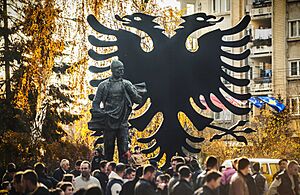
On February 17, 2008, Kosovo declared its independence from Serbia. Many countries around the world have recognized Kosovo as an independent country.
In November 2019, a big earthquake hit Albania. People in Kosovo showed great support. They raised money, collected food, clothes, and helped people who lost their homes. Many Kosovo Albanians opened their homes to those affected by the earthquake.
Who Lives in Kosovo?
Here's a table showing the different groups of people in Kosovo over the years:
| Year | Albanians |
Serbs |
Others |
Source and notes |
|---|---|---|---|---|
| 1921 | 61% | 33% | 6% | |
| 1931 | 58% | 29% | 13% | |
| 1948 | 65% | 26% | 9% | ICTY |
| 1953 | 65% | 24% | 10% | |
| 1961 | 67% | 23% | 9% | |
| 1971 | 73% | 19% | 7% | |
| 1981 | 76% | 16% | 8% | |
| 1991 | 80% | 13% | 7% | 1991 Census |
| 2000 | 87% | 9% | 4% | World Bank, OSCE |
| 2007 | 92% | 5% | 3% | OSCE |
| 2011 | 92.9% | 1.5% | 5.4% | 2011 Census |
Many Kosovo Albanians also live in other countries, especially in central Europe. This is called the Kosovan diaspora.
Kosovo Albanian Culture
The culture of Albanians in Kosovo is very similar to that of Albanians in Albania. However, traditions can be a bit different even from one town to another in Kosovo. The Albanian spoken in Kosovo is mostly the Gheg dialect. But for official things like schools, books, and news, the standard Albanian language is used, which is closer to the Tosk dialect.
Religion and Beliefs
Most Kosovo Albanians are Sunni Muslims. There are also Catholic Albanian communities, mainly in places like Gjakova and Prizren. Some Kosovo Albanian Muslims are also choosing to become Christian.
Art and Entertainment
Kosovafilm was a film company that made movies in Albanian. The National Theatre of Kosovo is a main place where plays are performed by both Albanian and international artists.
Music is a very important part of Albanian culture. Kosovo's music has been influenced by different cultures, but traditional Albanian music is still strong. It often uses instruments like the çiftelia (a traditional Albanian instrument), mandolina, and percussion. Folk music is very popular. Modern music in Kosovo includes pop, hip hop, rock, and jazz.
Learning and Education
Education is available at all levels, from primary school to university. The University of Pristina is the main public university in Kosovo. The National Library is the biggest library, located in Pristina. There are also many private universities and schools.
Famous Kosovo Albanians
You can find a list of well-known people from Kosovo in the List of Kosovo Albanians article.
See Also
- Albanians in Serbia
- Albanian nationalism in Kosovo
- Albania-Kosovo relations
Images for kids


